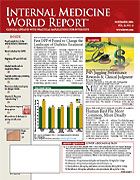Publication
Article
Internal Medicine World Report
Differentiating Between Types of Allergic Rhinitis Crucial for Treatment Choice
Differentiating Between Types of Allergic Rhinitis Crucial for Treatment Choice
By David Wild
Although patients with allergic rhinitis treated in a primary care setting are usually considered alike, grouping them into 2 categories based on whether their symptoms are intermittent or persistentwill improve the treatment outcomes of these patients, according to results of a new, prospective study (Ann Allergy Asthma Immunol. 2005;94:60-64).
Findings show that among patients with allergic rhinitis, those with intermittent symptoms of allergic rhinitis tend to be “sneezers and runners,” but persistent symptoms are associated with nasal “blockage.” Thus, differentiating between the 2 types is important.
The treatment implications of this division are profound, observes Timothy Craig, DO, of the Department of Pulmonary, Allergy and Critical Care Medicine, Penn State University College of Medicine. “Patients with allergic rhinitis tend to be grouped into 1 category in the general practice setting, and are prescribed antihistamines as a general rule,” Dr Craig says. “In fact, those with persistent rhinitis are better served with a steroid nasal spray, whereas intermittent allergies respond well to antihistamines.”
Lead investigator Puneet Khanna, MD, and Ashok Shah, MD, both of the Vallabhbhai Patel Chest Institute, University of Delhi, India, set out to describe the distinguishing features of patients with either intermittent or persistent allergic rhinitis. Included were 114 consecutive patients (mean age, 24 years) with clinically diagnosed allergic rhinitis, none of whom had ever smoked, and all had been symptomatic for at least 1 year before study outset. All the patients also had normal spirometry results.
Patients reporting sneezing and rhinorrhea for most days of the week were classified as “sneezers and runners.” In contrast, those with constant nasal blockage, postnasal drip, or thick nasal mucous discharge with little or no wheezing or no sneezing at all as their predominant symptoms were considered “blockers.” Grouped by their symptoms, 72 patients (63%) were in the first category and 42 (37%) in the second.
Patients were also analyzed based on demographics, medical histories, and environmental exposures to see if there were other characteristics unique to each of the 2 groups.
Results indicated that “sneezers and runners” were significantly more likely than “blockers” to have a family history of atopy and to suffer from itching in the eyes, throat and palate, ears, and skin (P <0.05 for all). Conversely, “blockers” were significantly more likely to have breathlessness, mouth breathing, history of previous nasal surgery, and loss of sense of smell (P <0.05 for all).
The investigators emphasized that physicians need to keep these distinct features in mind when considering a treatment plan for patients with allergic rhinitis.
“Because of associated breathlessness [in blockers], these patients could be mistakenly diagnosed as having asthma, with the possibility of rhinitis being overlooked,” they wrote. “Early identification of such patients assumes importance, since morbidity that results from unnecessary surgical procedures can be avoided.”
They added, “Because ‘sneezers and runners’ have significant associated allergic manifestations, these patients may possibly require oral antihistamines, in addition to nasal steroids, on a long-term basis, for better control of their symptoms. This classification also underscores the importance of regular administration of intranasal corticosteroid sprays throughout the year in ‘blockers,’ since antihistamines may not be effective in relieving persistent symptoms in these patients.”
